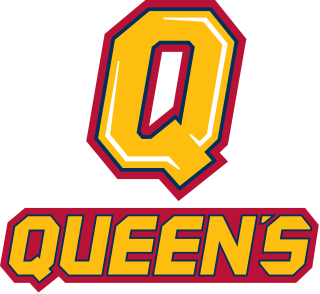Related Research Articles

Synchronized swimming or artistic swimming is a sport where swimmers perform a synchronized choreographed routine, accompanied by music. The sport is governed internationally by FINA. It is traditionally a women's sport, although FINA introduced a new mixed gender duet competition that included one male swimmer in each duet at the 2015 World Aquatics Championships and LEN introduced men's individual events at the 2022 European Aquatics Championships.

The Queen's Gaels is the Athletics program representing Queen's University at Kingston in Kingston, Ontario, Canada. Team colours are blue, red, and gold. The main athletics facilities include Richardson Memorial Stadium, the Queen's Athletics and Recreation Centre, Nixon Field and Tindall Field.

The Guelph Gryphons are the athletic teams that represent the University of Guelph in Guelph, Ontario, Canada. The university's varsity teams compete in the Ontario University Athletics conference of the U Sports(OUA's), and, where applicable, in the west division. The university teams are often referred to as the Gryphs, which is short for the school's mascot, Gryph, the gryphon.

Ontario University Athletics is a regional membership association for Canadian universities which assists in co-ordinating competition between their university level athletic programs and providing contact information, schedules, results, and releases about those programs and events to the public and the media. This is similar to what would be called a college athletic conference in the United States. OUA, which covers Ontario, is one of four such bodies that are members of the country's governing body for university athletics, U Sports. The other three regional associations coordinating university-level sports in Canada are Atlantic University Sport (AUS), the Canada West Universities Athletic Association (CW), and Réseau du sport étudiant du Québec (RSEQ).
Marie-Pier Boudreau Gagnon is a Canadian synchronized swimmer and four times Commonwealth Games gold medalist.

Svetlana Alekseyevna Romashina is a Russian synchronized swimmer that boasts 41 total gold medals from competing in four Olympic Games, seven world championships and six European championships. She has never placed lower than first at any of these events, and by adding two more golds in the 2020 Summer Olympics she broke all medal-count ties to become the most decorated athlete ever in her sport.
Claire Rhiannon Carver-Dias is a Canadian competitor in synchronized swimming and Olympic medallist.

The Queen's Cup is a trophy awarded annually to the champion in men's ice hockey of the Ontario University Athletics conference of U Sports. It has been awarded since 1903 to the champion between Ontario and Quebec universities. It is the second-oldest ice hockey trophy still being awarded, after the Stanley Cup.
The Golden Path Trophy is a national collegiate sports award, presented annually to the women's ice hockey champions of U Sports, Canada's governing body for university sports. The trophy was donated by Katherine Cartwright in 1998, which is when the championship was first contested. Cartwright was the first head coach of the Queen's Gaels women's hockey program in 1971 and led the movement to reinstate women's hockey at the collegiate level in 1960, following a nine-year hiatus.
Arthur Byron MacDonald is an American Canadian swimming coach who helms the Toronto Varsity Blues swim teams at the University of Toronto. He is a former swimmer who competed for Canada in the 1972 Summer Olympics in Munich, Germany. MacDonald placed sixth in the final of the men's 100-metre butterfly, and also competed in the preliminary heats of the 200-metre butterfly, but did not advance. He is currently the head coach of the Toronto Titans for the International Swimming League, and has also
Mary Killman is an American synchronized swimmer. After switching to synchronized swimming from race swimming, Killman was a member of the teams that won silver medals in the duet and team competitions at the 2011 Pan American Games in Guadalajara, Mexico and 2015 Pan American Games in Toronto, Ontario, Canada.
Élise Marcotte was a Canadian synchronized swimmer who competed in the 2008 and 2012 Summer Olympics.

Jacqueline Simoneau is a Canadian synchronized swimmer.

Aleksandr Evgenyevich Maltsev is a 4-time world champion and 6-time European champion in artistic swimming and a founder of men's artistic swimming in Russia. Aleksandr is the most titled male artistic swimmer in the world. He is recognized as the best male artistic swimmer in the world by the International Swimming Federation (FINA) and as the best male artistic swimmer in Europe by the European Swimming League (LEN).
Sue Baross Nesbitt, is an American synchronized swimming champion and international coach. She is currently the head coach with the Riverside Aquettes in Riverside, California.

Anita Álvarez is an American artistic and synchronized swimmer. Originally from Buffalo, New York, she attended Kenmore West Senior High School, from which she graduated in 2014. She began her professional synchronized swimming career after she graduated.

Canada competed at the 2017 World Aquatics Championships in Budapest, Hungary from 14 July to 30 July.

Mayuko Fujiki is a synchronized swimming coach originally from Japan. She is the head coach of the Spanish National Synchronized Swimming Team.
Deborah Muir is a Canadian former synchronized swimmer and coach. She began her career with the Calgary Aquabelles club in 1965 and won silver medals in the synchronized swimming team competitions at both the 1971 Pan American Games and the 1973 World Aquatics Championships. At age 20, Muir retired from competition and began a career in coaching. She coached swimmers of the Calgary Aquabelles to 22 national titles over a decade. She also helped athletes clinch medals in the World Aquatics Championships, the FINA Cup, the Commonwealth Games, the Pan American Games and the Summer Olympic Games. Muir has won various awards for her coaching career, and is an inductee of the Alberta Sports Hall of Fame, the Canadian Olympic Hall of Fame, Canada's Sports Hall of Fame and the International Swimming Hall of Fame.
Sylvie Fortier is a Canadian former synchronized swimmer. She won medals in Canadian provincial and national competitions, at the World Aquatics Championships, the Pan American Games and the Pan Pacific Games. Fortier was named the 1976 world champion in synchronized swimming for her achievements that year and was a torch bearer for the opening ceremony of the Montreal Summer Olympics. She retired in 1977 aged just 18. Fortier is an inductee of Canada's Sports Hall of Fame and the Aquatics Hall of Fame.
References
- ↑ "Home". Canadian University Artistic Swimming League. Retrieved 2019-03-19.
- ↑ Gladys Bean, History of Synchronized Swimming in Canada (1975)
- 1 2 "Synchronized swimming in Canada | CUASL Brief History". Archived from the original on 2022-04-08. Retrieved 2022-06-29.
- ↑ "Sabrina Lekadir: Doing Big Things with a Small Club | Her Campus". 7 October 2012.